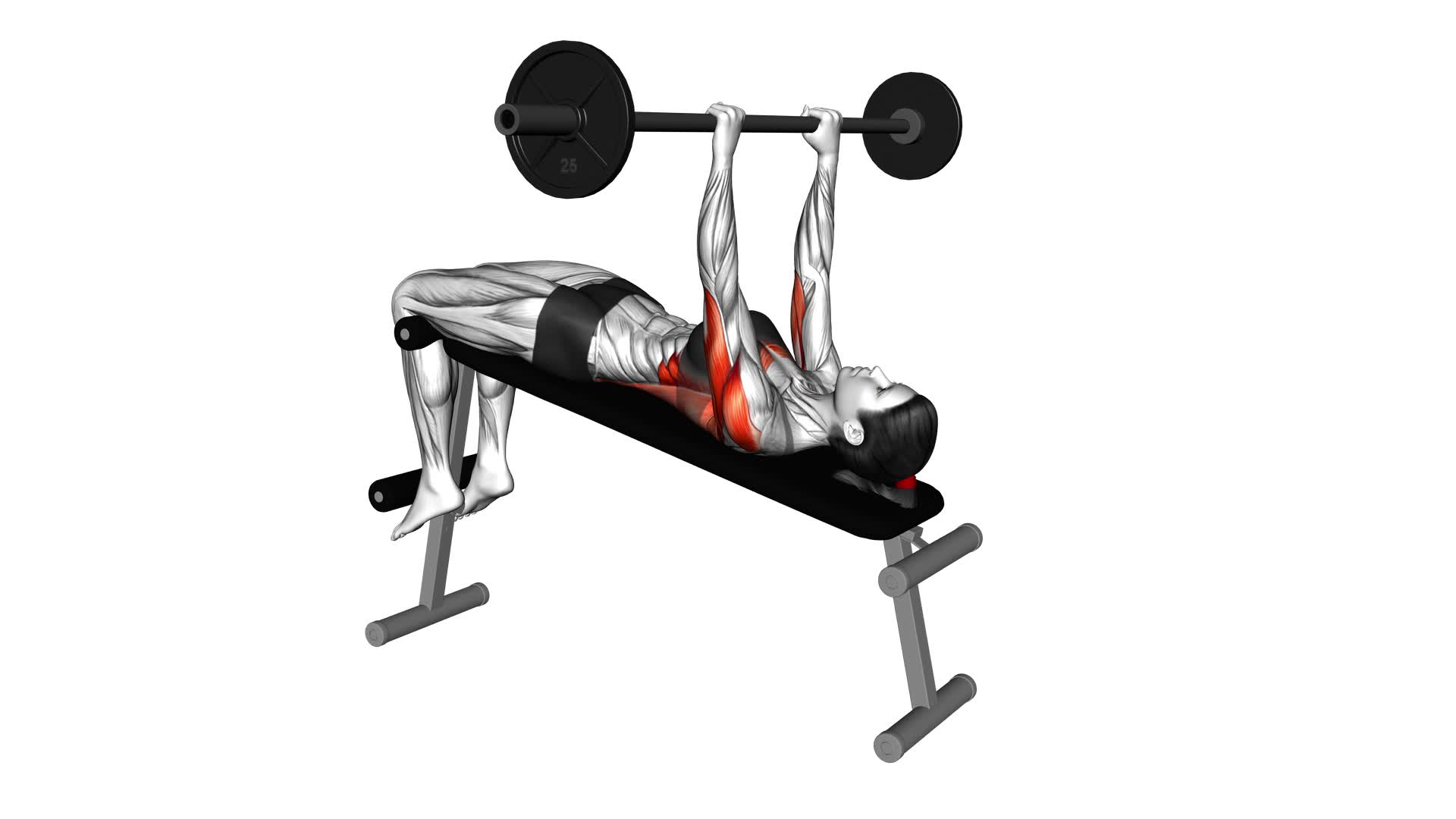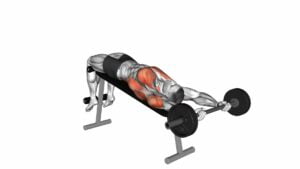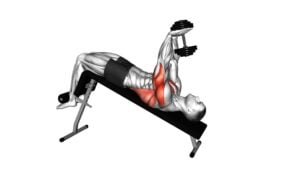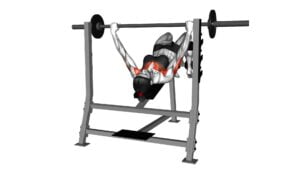Barbell Decline Pullover (female) – Video Exercise Guide & Tips

Are you looking for a challenging and effective exercise to target your upper body?
Watch This Exercise Video
Look no further than the barbell decline pullover.
This exercise is specifically designed for women to build strength and tone their muscles.
In this video exercise guide, you'll learn the proper form and technique, as well as variations to target different muscle groups.
Avoid common mistakes and maximize your results with these expert tips.
Get ready to take your workout to the next level.
Key Takeaways
- Targets muscles in the back, chest, and shoulders
- Improves posture and upper body strength
- Increases overall muscle definition
- Develops core stability and balance
Benefits of the Barbell Decline Pullover
To maximize your workout, the barbell decline pullover offers a variety of benefits for female athletes. This exercise primarily targets the muscles in your back, chest, and shoulders, making it a great way to activate and strengthen these key areas. By engaging these muscles, you can improve your posture, enhance upper body strength, and increase overall muscle definition.
The barbell decline pullover also helps to develop core stability and balance, as it requires you to maintain control throughout the movement. Additionally, this exercise can improve shoulder mobility and flexibility, reducing the risk of injury during other exercises or daily activities. Incorporating the barbell decline pullover into your routine can lead to improved athletic performance and functional movement.
It's important to note that proper form and technique are crucial for maximizing the benefits of this exercise. Transitioning into the subsequent section on proper form and technique, let's explore how to perform the barbell decline pullover correctly to ensure optimal results.
Proper Form and Technique for the Exercise
To perform the barbell decline pullover with proper form and technique, you should position yourself on a decline bench with a barbell loaded with an appropriate weight. Lie on the bench with your feet securely placed on the ground and your knees slightly bent. Grasp the barbell with an overhand grip, slightly wider than shoulder-width apart.
Begin the exercise by lowering the barbell behind your head in a controlled manner, ensuring that your arms remain straight throughout the movement. Keep your core engaged and maintain a slight bend in your elbows to avoid placing excessive stress on the joints.
As you pull the barbell back up, focus on using your chest and back muscles, rather than your arms, to drive the movement. This will help you maximize the results and effectively target the intended muscles.
It's important to avoid common mistakes such as arching your back excessively or using momentum to lift the weight. Instead, concentrate on maintaining proper form and executing the exercise with controlled, deliberate movements.
Variations to Target Different Muscle Groups
To target different muscle groups, you can incorporate variations into your barbell decline pullover exercise routine.
One option is to try alternative exercises for upper body strength. For example, instead of using a barbell, you can use dumbbells or a cable machine to perform decline pullovers. This variation can help to engage different muscles in your upper body, including your chest, shoulders, and back.
Another way to target different muscle groups is to incorporate the barbell decline pullover into a full body workout routine. By combining this exercise with other compound movements, such as squats, deadlifts, and overhead presses, you can work multiple muscle groups simultaneously. This not only saves time but also helps to increase overall strength and coordination.
Additionally, you can modify the grip width during the decline pullover to target specific areas of your upper body. A wider grip can emphasize the chest muscles, while a narrower grip can target the triceps and shoulders.
Remember to always maintain proper form and technique when performing any variation of the barbell decline pullover. It's important to start with lighter weights and gradually increase the load as you become more comfortable and confident. Consult with a certified fitness professional to ensure proper execution and to tailor the exercises to your specific fitness goals.
Common Mistakes to Avoid
Avoiding common mistakes is crucial when performing the barbell decline pullover exercise. By avoiding these mistakes, you can ensure that you're maximizing the benefits of the exercise while minimizing the risk of injury.
One common mistake to avoid is using too much weight. It's important to start with a weight that you can handle comfortably and gradually increase it as you become stronger. Using too much weight can put excessive strain on your shoulders and back, potentially leading to injury.
Another mistake to avoid is using improper form. When performing the barbell decline pullover, it's important to maintain proper alignment and control throughout the movement. Avoid swinging the barbell or using momentum to lift the weight. Instead, focus on engaging your core muscles and using the targeted muscle groups to perform the exercise.
If you find that the barbell decline pullover is causing discomfort or pain, it's important to listen to your body and modify or find alternative exercises. There are several alternatives to the barbell decline pullover that can target the same muscle groups without putting as much strain on your shoulders and back. Some alternatives include dumbbell pullovers, cable pullovers, or using a stability ball instead of a decline bench.
Tips for Maximizing Your Results
Maximize your results with these helpful tips for the barbell decline pullover exercise.
- Focus on proper form: To maximize progress and optimize performance, it's crucial to maintain proper form throughout the exercise. Keep your core engaged, maintain a slight bend in your elbows, and avoid arching your back excessively. This will ensure that you target the intended muscles effectively.
- Gradually increase weight: As you become more comfortable with the exercise, gradually increase the weight you use. This progressive overload will challenge your muscles and promote strength and muscle growth over time. However, it's important to listen to your body and avoid overloading too quickly, as this can lead to injury.
- Control the movement: Rather than relying on momentum, focus on controlling the movement during the exercise. Slowly lower the barbell behind your head and then bring it back up using controlled and deliberate movements. This will engage the targeted muscles more effectively and yield better results.
- Incorporate proper breathing techniques: Pay attention to your breathing during the exercise. Inhale as you lower the barbell and exhale as you bring it back up. This helps with maintaining stability and ensuring that you're effectively engaging your muscles.
Frequently Asked Questions
How Much Weight Should I Use for the Barbell Decline Pullover Exercise?
To determine the optimal weight for the barbell decline pullover, start with a weight that challenges you but allows for proper form. Gradually increase the weight as you become stronger and more comfortable with the exercise.
It's important to find a balance between pushing yourself and maintaining control throughout the movement. Remember to listen to your body and adjust the weight accordingly.
Can I Substitute the Barbell With Dumbbells for This Exercise?
Yes, you can substitute the barbell with dumbbells for the decline pullover exercise. Using dumbbells can offer several benefits, such as increased stability and range of motion.
It also allows you to work each side of your body independently, targeting any imbalances. Start with a weight that challenges you but still allows you to maintain proper form. Gradually increase the weight as you get stronger.
Always consult with a fitness professional for personalized advice.
How Often Should I Include the Barbell Decline Pullover in My Workout Routine?
To maximize the benefits of the barbell decline pullover, it's important to include it in your workout routine with the right frequency.
This exercise targets your chest, back, and shoulder muscles, helping to improve upper body strength and stability.
Aim to incorporate it into your routine 1-2 times per week to allow for proper recovery and muscle growth.
Remember to start with lighter weights and gradually increase as you become more comfortable with the exercise.
Is It Necessary to Have a Decline Bench to Perform This Exercise, or Can I Do It on a Flat Bench?
To perform the Barbell Decline Pullover, a decline bench is typically used. However, if you don't have access to one, you can do it on a flat bench as an alternative.
Keep in mind that using a decline bench offers some benefits, such as increased range of motion and targeting the lower chest muscles. But with proper form and technique, you can still effectively work your upper body on a flat bench.
Can the Barbell Decline Pullover Help Improve My Posture?
The barbell decline pullover exercise can be beneficial for improving your posture. By targeting your upper back, shoulders, and chest, it helps strengthen the muscles that support proper alignment.
This exercise also engages your core muscles, promoting stability and balance. Incorporating the barbell pullover into your routine can lead to better posture over time.
The benefits of this exercise extend beyond just posture improvement, as it also helps increase upper body strength and flexibility.
Conclusion
In conclusion, the barbell decline pullover is an effective exercise for targeting various muscle groups. By maintaining proper form and technique, you can maximize the benefits and avoid common mistakes.
Additionally, incorporating variations of this exercise can help target specific muscle groups. By following these tips and guidelines, you can achieve optimal results and improve your overall fitness level.

Author
Years ago, the spark of my life’s passion ignited in my mind the moment I stepped into the local gym for the first time. The inaugural bead of perspiration, the initial endeavor, the very first surge of endorphins, and a sense of pride that washed over me post-workout marked the beginning of my deep-seated interest in strength sports, fitness, and sports nutrition. This very curiosity blossomed rapidly into a profound fascination, propelling me to earn a Master’s degree in Physical Education from the Academy of Physical Education in Krakow, followed by a Sports Manager diploma from the Jagiellonian University. My journey of growth led me to gain more specialized qualifications, such as being a certified personal trainer with a focus on sports dietetics, a lifeguard, and an instructor for wellness and corrective gymnastics. Theoretical knowledge paired seamlessly with practical experience, reinforcing my belief that the transformation of individuals under my guidance was also a reflection of my personal growth. This belief holds true even today. Each day, I strive to push the boundaries and explore new realms. These realms gently elevate me to greater heights. The unique combination of passion for my field and the continuous quest for growth fuels my drive to break new ground.







